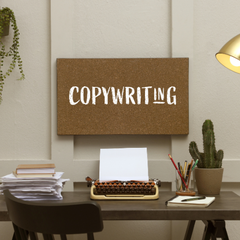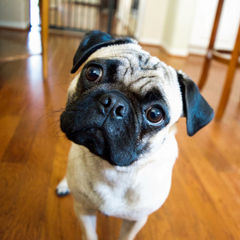
In today's fast-paced world, grabbing attention isn't enough; you need to convert it into action.
Mastering creative copywriting is your secret weapon to captivate audiences and drive conversions.
In this post, we’re diving deep into the world of creative copywriting, unpacking what it really means, and serving up 12 killer tips that will take your skills from meh to mind-blowing. Ready to turn your words into cash? Let’s get started.
What is Creative Copywriting?

Creative copywriting is all about blending imagination with persuasive writing to craft messages that not only inform but also entertain and engage the reader. Unlike traditional copywriting, which often sticks to straightforward, direct messages, creative copywriting brings in elements of storytelling, humor, and clever wordplay to make the content memorable.
Think of it as the difference between a plain ad that just tells you to buy a product and a creative copy ad that makes you laugh, think, and feel a connection to the brand. Creative copywriters excel at weaving narratives that draw readers in, using metaphors, analogies, and vivid descriptions to paint a picture that sticks in the mind long after they've finished reading.
Ultimately, creative copywriting aims to achieve the same goal as any other form of copywriting: to persuade the reader to take a desired action, whether that’s making a purchase, signing up for a newsletter, or sharing content. However, it does so in a way that’s engaging and entertaining, making the message more impactful and memorable.
What’s the Difference Between Creative Writing and Copywriting?

It’s easy to confuse creative writing with copywriting, but they serve different purposes and follow different rules.
Creative writing is all about expressing ideas and emotions through imaginative storytelling. Think novels, short stories, poems, and even screenplays. The primary goal here is to entertain or provoke thought without necessarily driving the reader to take a specific action.
Copywriting, on the other hand, is all about persuasion. The goal is to compel the reader to take a specific action, whether it’s buying a product, signing up for a service, or clicking on a link. While creative copywriting does employ elements of creative writing—like storytelling and engaging language—it’s always focused on driving conversions.
Here’s a quick breakdown:
- Purpose: Creative writing aims to entertain or inform; copywriting aims to persuade.
- Structure: Creative writing can be free-form and flexible; copywriting is typically structured to guide the reader towards a specific action.
- Tone: Creative writing explores a range of tones and styles; copywriting often adopts a tone that’s aligned with the brand’s voice and the audience’s expectations.
In essence, creative copywriting merges the best of both worlds: the compelling, imaginative elements of creative writing and the strategic, results-driven nature of copywriting. This blend is what makes creative copy so effective and memorable.
12 Creative Copywriting Tips to Take Your Skills to the Next Level
1. Know Your Audience Inside and Out

The first rule of any form of copywriting is to know your audience, but this is especially true for creative copywriting. You can't craft compelling and engaging content if you don't understand who you're writing for. Dive deep into your audience's demographics, interests, pain points, and desires. The more you know about them, the more effectively you can tailor your message to resonate.
Imagine you’re writing for a tech-savvy audience who loves innovation. Your creative copy should reflect that with clever tech references, cutting-edge jargon, and futuristic themes. Conversely, if your audience is more traditional, your creativity might come through in a more nostalgic, heartfelt way.
Understanding your audience’s preferences will guide your creative decisions, ensuring your copy not only stands out but also strikes a chord.
2. Tell a Story
Stories are powerful.
They captivate attention, make your message relatable, and stick in the reader's mind. As a creative copywriter, incorporating storytelling into your copy can transform dry facts into engaging narratives. Whether it’s a customer success story, a brand’s origin tale, or a simple anecdote that illustrates a point, stories can make your copy come alive.
Consider the way Apple tells the story of its products. They don’t just list features; they craft a narrative around how those features improve your life. They show people using their products in everyday situations, overcoming challenges, and experiencing joy. This storytelling approach makes their creative copywriting not just informative, but also emotionally resonant.
So, next time you sit down to write, think about the story you can tell. Maybe it’s about a customer whose life was changed by your product, or perhaps it’s a behind-the-scenes look at your brand’s journey.
Use storytelling to draw your readers in and make them care about what you have to say.
3. Leverage Emotional Triggers

Emotions drive decisions. Tapping into your audience’s emotions can significantly boost the effectiveness of your creative copywriting. Fear, excitement, joy, and even nostalgia are powerful motivators. Use these emotional triggers to connect with your audience on a deeper level.
For instance, fear of missing out (FOMO) is a popular tactic in creative copy ads. Highlighting limited-time offers or exclusive deals can create a sense of urgency that compels readers to act quickly. On the other hand, highlighting the joy and satisfaction that comes from using a product can evoke positive emotions that encourage purchases.
Experiment with different emotional triggers in your copy. Think about what emotions your product or service naturally evokes and amplify those feelings in your messaging. Emotional resonance can turn a good copy into a great one.
4. Use Visual Language
Visual language makes your copy more vivid and engaging. Instead of telling your audience about a feature, show them. Paint a picture with your words that helps the reader visualize the benefits of your product or service. This technique is particularly powerful in creative copywriting, where the goal is to create memorable and impactful content.
For example, instead of saying, "Our software improves efficiency," you could say, "Our software cuts through the clutter like a hot knife through butter, streamlining your workflow and freeing up your time for what really matters." This creates a strong mental image that sticks with the reader.
To effectively use visual language, touch on the reader’s five senses:
- Sight: Describe colors, shapes, and visual scenes. "Imagine a bright, sunlit office where everything is in its place."
- Sound: Use auditory details to add depth. "Hear the quiet hum of your computer as you breeze through tasks."
- Touch: Convey textures and physical sensations. "Feel the smooth, ergonomic design of our product in your hand."
- Taste: Though less common, taste can be powerful. "Like savoring a rich, dark chocolate, our service is a delight."
- Smell: Evoke scents to trigger memories. "The fresh, clean scent of a newly opened package."
When readers can see, feel, or even taste what you're describing, they're more likely to remember and act on it.
5. Be Unexpected
One of the hallmarks of creative copywriting is its ability to surprise and delight. When your copy takes an unexpected turn, it grabs attention and keeps readers engaged. Think about ways you can introduce an element of surprise into your writing. It could be through a surprising fact, a clever twist, or an unusual analogy.
Take inspiration from the famous Volkswagen "Think Small" campaign. Instead of touting the car's features like everyone else, they embraced its small size and turned it into a positive attribute. This unexpected approach made the ads stand out and resonate with audiences.
Being unexpected doesn’t mean being random. The surprise should be relevant and enhance the core message of your copy. Aim to make your readers pause, think, and smile. A little twist can make your creative copy memorable and effective. For example, if you're writing about a financial service, you might start with a story about a squirrel storing nuts for winter—unexpected, but it effectively illustrates the importance of saving.
6. Embrace Conciseness

In creative copywriting, less is often more. Embracing conciseness means delivering your message in as few words as possible while maintaining impact and clarity. This is especially important in today's world where attention spans are short and every word counts.
Legendary copywriter Gary Halbert often emphasized the power of brevity. He believed that stripping down your copy to its most essential elements forces you to communicate more effectively. Think about Twitter's character limit—how can you say more with less?
Here’s how to embrace conciseness:
- Cut the Fluff: Remove any unnecessary words or phrases that don’t add value. If a sentence can be simplified, do it.
- Be Direct: Get straight to the point. Avoid long-winded introductions or overly complex explanations.
- Use Short Sentences and Paragraphs: This makes your copy easier to read and digest. Break up long blocks of text to keep readers engaged.
For example, instead of saying, "Our innovative solution offers a range of features that help to significantly improve efficiency," say, "Our solution boosts efficiency—fast." This gets the message across quickly and clearly.
By keeping your creative copy concise, you ensure that every word serves a purpose and keeps your readers hooked from start to finish.
7. Inject Humor

Humor can be a powerful tool in creative copywriting. It humanizes your brand, makes your message more relatable, and can create a memorable connection with your audience. When used appropriately, humor can break down barriers and make your copy more engaging.
Take a look at brands like Old Spice or Dollar Shave Club. Their humorous approach to advertising has set them apart in the market and created a loyal following. Their creative copy ads are not only funny but also effectively communicate the benefits of their products.
Here’s how to inject humor into your copy:
- Know Your Audience: Understand what type of humor will resonate with your audience. What’s funny to one group might not be to another.
- Keep It Relevant: Make sure the humor aligns with your brand and the message you’re trying to convey. It should enhance your point, not distract from it.
- Be Light-hearted: Avoid offensive or divisive jokes. Aim for humor that’s universally enjoyable and in good taste.
For example, instead of saying, “Our product works well,” you might say, “Our product works so well, it’s like having a tiny wizard in your pocket.” This adds a playful twist that can make your copy more enjoyable to read.
Injecting humor can make your creative copy stand out and leave a lasting impression on your audience.
8. Make Your Headlines Irresistible
Headlines are the first thing your audience sees, and they can make or break the success of your copy. An irresistible headline grabs attention, sparks curiosity, and entices the reader to keep reading. Think of it as your first impression—you want it to be unforgettable.
To craft compelling headlines, consider these strategies:
- Ask Questions: Engage readers by asking a question that piques their interest. “Are You Making These Common Copywriting Mistakes?”
- Use Numbers: Numbers promise specific, digestible information. “5 Tips for Crafting Perfect Headlines Every Time”
- Offer a Solution: Highlight the benefit or solution your content provides. “How to Double Your Conversions with Creative Copywriting”
Remember, a great headline can significantly boost the effectiveness of your creative copy by drawing readers in and making them eager to learn more.
9. Incorporate Social Proof

Social proof is a powerful element in creative copywriting because it leverages the influence of others to build trust and credibility. When potential clients see that others have had positive experiences with your product or service, they’re more likely to trust your offering and take action.
Ways to incorporate social proof:
- Testimonials: Use quotes from satisfied customers to highlight the benefits and effectiveness of your product. “Jane Doe boosted her sales by 50% using our service!”
- Case Studies: Share detailed stories of how your product or service helped solve a problem for a client. “See how Company X increased their conversions with our solution.”
- Reviews and Ratings: Highlight positive reviews and high ratings from third-party platforms. “Rated 4.8 stars by over 1,000 happy customers.”
Take, for instance, how Amazon prominently displays customer reviews and ratings for products. This practice helps new customers feel more confident in their purchasing decisions.
Adding social proof to your creative copy ads not only enhances credibility but also helps to reassure potential clients that they’re making a wise choice.
10. Use Metaphors to Simplify Complex Ideas
Metaphors are a fantastic tool in creative copywriting for simplifying complex ideas and making your message more relatable. By comparing something unfamiliar to something familiar, you help your audience understand and connect with your content more easily.
Think about the classic metaphor used in marketing: “Your website is your digital storefront.” This simple comparison helps business owners quickly grasp the importance of a well-designed website without needing a lengthy explanation.
How to effectively use metaphors:
- Identify the Core Idea: Determine the main point you want to communicate.
- Find a Relatable Comparison: Choose something your audience is familiar with that shares characteristics with your core idea.
- Keep It Simple: Ensure the metaphor is straightforward and easy to understand.
For instance, if you’re writing about a complex software solution, you might say, “Our software works like a personal assistant, managing your tasks effortlessly and freeing up your time.” This metaphor makes the software’s benefits clear and relatable.
Using metaphors can make your creative copy more vivid and easier to grasp, enhancing both engagement and comprehension.
11. Tie In Current Events
Leveraging current events in your creative copywriting can make your content more timely, relevant, and engaging. When you tie your message to something happening in the world right now, you capture your audience’s attention and make your copy feel fresh and up-to-date.
Here’s how to do it effectively:
- Stay Informed: Keep up with the latest news, trends, and events in your industry and the world at large. Tools like Google Alerts or following key influencers on social media can help.
- Be Relevant: Ensure that the current event you’re referencing is relevant to your audience and your message. A connection that feels forced or off-topic can do more harm than good.
- Add Value: Use the event to add value to your message. Explain how it impacts your audience or draw insightful parallels that enhance your point.
For example, during the COVID-19 pandemic, many companies tailored their messaging to address new challenges people were facing. A fitness brand might write, “Staying active at home is more important than ever. Here’s how our equipment can help you keep fit during lockdowns.”
By tying in current events, you make your creative copy more compelling and relatable, showing that your brand is in tune with what’s happening in the world and cares about its audience’s current experiences.
12. Pique Curiosity

One of the most effective ways to engage readers in creative copywriting is to pique their curiosity. When you arouse curiosity, you encourage your audience to continue reading to satisfy their need for answers. This technique keeps them hooked from the first sentence to the last.
Strategies to pique curiosity:
- Ask Provocative Questions: Start with a question that makes the reader want to find out more. “What if you could double your productivity with just one simple change?”
- Tease Information: Give a hint of valuable information without revealing everything upfront. “Discover the secret to boosting conversions that top marketers don’t want you to know.”
- Create Mystery: Use phrases that suggest there’s something exciting to uncover. “Unlock the hidden potential of your marketing strategy with this unexpected tip.”
Consider how BuzzFeed uses curiosity in their headlines: “10 Unbelievable Facts You Didn’t Know About…” This style of headline makes readers want to click to learn more, even if they weren’t initially interested in the topic.
By piquing curiosity, you create a sense of intrigue that draws readers in and compels them to engage with your creative copy until they find the answers they’re looking for.
Conclusion
Use these 12 creative copywriting tips to transform your writing and earn more $$$ in 2024 (and beyond).
Want daily copywriting tips to help you leapfrog over competition and attract clients to you with magnetic force? Enter your email below:
